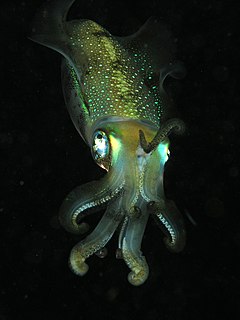
A cephalopod is any member of the molluscan class Cephalopoda such as a squid, octopus or nautilus. These exclusively marine animals are characterized by bilateral body symmetry, a prominent head, and a set of arms or tentacles modified from the primitive molluscan foot. Fishermen sometimes call them inkfish, referring to their common ability to squirt ink. The study of cephalopods is a branch of malacology known as teuthology.

The nautilus is a pelagic marine mollusc of the cephalopod family Nautilidae, the sole extant family of the superfamily Nautilaceae and of its smaller but near equal suborder, Nautilina.

The Nautilida constitute a large and diverse order of generally coiled nautiloid cephalopods that began in the mid Paleozoic and continues to the present with a single family, the Nautilidae which includes two genera, Nautilus and Allonautilus, with six species. All told, between 22 and 34 families and 165 to 184 genera have been recognised, making this the largest order of the subclass Nautiloidea.

Ommastrephidae is a family of squid containing three subfamilies, 11 genera, and over 20 species. They are widely distributed globally and are extensively fished for food. One species, Todarodes pacificus, comprises around half of the world's cephalopod catch annually.

The siphuncle is a strand of tissue passing longitudinally through the shell of a cephalopod mollusk. Only cephalopods with chambered shells have siphuncles, such as the extinct ammonites and belemnites, and the living nautiluses, cuttlefish, and Spirula. In the case of the cuttlefish, the siphuncle is indistinct and connects all the small chambers of that animal's highly modified shell; in the other cephalopods it is thread-like and passes through small openings in the walls dividing the chambers.

Nautiloids are a large and diverse group of marine cephalopods (Mollusca) belonging to the subclass Nautiloidea that began in the Late Cambrian and are represented today by the living Nautilus and Allonautilus. Nautiloids flourished during the early Paleozoic era, where they constituted the main predatory animals, and developed an extraordinary diversity of shell shapes and forms. Some 2,500 species of fossil nautiloids are known, but only a handful of species survive to the present day.

An orthocone is an unusually long straight shell of a nautiloid cephalopod. During the 18th and 19th centuries, all shells of this type were named Orthoceras, creating a wastebasket taxon, but it is now known that many groups of nautiloids developed or retained this type of shell.

Corydalis is a genus of about 470 species of annual and perennial herbaceous plants in the Papaveraceae family, native to the temperate Northern Hemisphere and the high mountains of tropical eastern Africa. They are most diverse in China and the Himalayas, with at least 357 species in China.
The Wenlock Group (Wenlockian), in geology, is the middle series of strata in the Silurian of Great Britain. This group in the typical area in the Welsh border counties contains the following formations: Much Wenlock Limestone Formation, 90–300 ft.; Wenlock Shale, up to 1900 ft.; Woolhope or Barr Limestone and shale, 150 ft.
The Ludlow Group are geologic formations deposited during the Ludlow epoch of the Silurian period in the British Isles, in areas of England, Ireland, Scotland, and Wales.
Cameroceras is a genus of extinct, giant orthoconic cephalopod that lived mainly during the Ordovician period. It first appears during the middle Ordovician, around 470 million years ago, and was a fairly common component of the fauna in some places during the period, inhabiting the shallow seas of Laurentia, Baltica and Siberia. Its diversity and abundance became severely reduced following the Ordovician–Silurian extinction events, and the last remnants of the genus went extinct sometime during the Wenlock.
Engorthoceratidae is a small family of Devonian orthocerids and a class of cephalopod found in eastern North America, containing only the genus Engorthoceras.
Sactoceras is an extinct nautiloid cephalopod that lived during the Ordovician and Silurian in what would become North America, Europe, and Asia.
Vologdinella is a genus of Middle Cambrian fossils that, while historically aligned to the cephalopods, has since been removed from this group. It contains a single species, Vologdinella antiqua. It was originally described and illustrated as Orthoceras? antiquus by the Russian paleontologist Aleksandr Grigoryevich Vologdin in 1931, from a Paleozoic limestone in the Chinguiz Mountains of Kazakhstan. It was made the type species of Vologdinella by Z. G. Balashov in 1962. The organism bears superficial resemblance to Agmata such as Volborthella and Salterella, but Yochelson & Kisselev (2003) considered it to be not related to them.
Temperoceras is a genus of orthoconic nautiloid cephalopods named by Barskov in 1960 that lived in what is now north Africa, Europe, and Asia during the early Paleozoic.
Aethiosolen is a genus of orthocerids in the family Orthoceratidae with an annulated orthoconic shell.
Aggregata is a genus of parasitic alveolates belonging to the phylum Apicomplexa.

Belemnites is a genus of an extinct group of cephalopods belonging to the order Belemnitida. These cephalopods existed in the Early Jurassic period from the Hettangian age to the Toarcian age (175.6–183.0). They were fast-moving nektonic carnivores.









